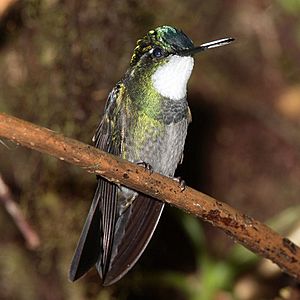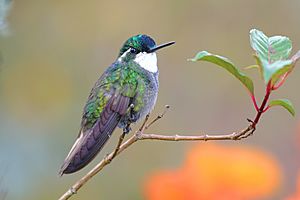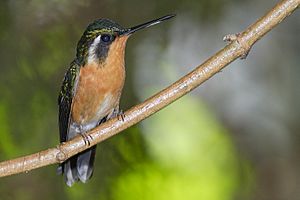White-throated mountaingem facts for kids
Quick facts for kids White-throated mountaingem |
|
|---|---|
 |
|
| Conservation status | |
| Scientific classification | |
| Genus: |
Lampornis
|
| Species: |
castaneoventris
|
| Synonyms | |
|
Lampornis castaneoventris castaneoventris (Gould, 1851) |
|
The white-throated mountaingem (Lampornis castaneoventris) is a small, colorful hummingbird. It lives only in the mountains of Panama. This bird is known for its quick flying and its beautiful feathers.
Contents
About the White-Throated Mountaingem
Scientists group animals into different families and species. The white-throated mountaingem is a type of hummingbird. Some scientists think it's its own unique species. Others believe it's a subspecies, meaning a special kind, of a larger group that includes the grey-tailed mountaingem. It's all about how they classify these amazing birds!
What Does It Look Like?
This hummingbird is about 12 centimeters (about 4.7 inches) long. It weighs around 5 to 6 grams (about 0.2 ounces), which is super light! It has a straight black beak and dark cheeks. There is a white stripe right behind its eye.
Male white-throated mountaingems have dark green feathers on their upper body. Their head is a bright emerald green, and their tail is black or bluish-black. Their chin and throat are white, and their chest is bright green. The lower part of their body is dark gray.
Female white-throated mountaingems have bright green feathers all over their upper body. Their middle tail feathers are dark green, and the outer ones are lighter. Their throat and belly are a reddish-brown color.
Where Does It Live?
The white-throated mountaingem lives only in the mountains of western Panama. Specifically, you can find it in a place called Chiriquí Province.
It likes to live inside forests, at the edges of forests, and in clearings with shrubs. You might even see it in gardens near the forest! These birds live at high elevations, from about 1,500 meters (about 4,900 feet) up to the tree line, which is where trees stop growing because it's too cold.
Behavior and Habits
Movement
The white-throated mountaingem stays in Panama all year long. It does not migrate to other places.
Feeding
This hummingbird loves to drink nectar from many different kinds of flowers. Male birds often find nectar on plants that grow on trees, called epiphytes, deep inside the forest. Female birds usually look for food in shrubby areas.
Males are very protective of their favorite flower patches. They will chase away smaller hummingbirds. However, bigger hummingbirds, like the fiery-throated hummingbird, can sometimes push them away. Besides nectar, these birds also eat small arthropods (like insects or spiders) that they pick off leaves.
Reproduction
The white-throated mountaingem's breeding season is from October to April. The nest is shaped like a cup. It's made from fine plant fibers and decorated with moss and lichen on the outside. Scientists don't yet know how long the eggs take to hatch or how long the baby birds stay in the nest.
Vocalization
These hummingbirds make high-pitched calls. People describe them as "ziit" or "ziip." They also have a "sputtery, bubbly" song.
Status and Conservation
The white-throated mountaingem is currently listed as a species of "Least Concern" by the IUCN. This means it's not in immediate danger of disappearing. Even though it has a small area where it lives, and we don't know exactly how many there are, it is considered a common bird.
However, this hummingbird could be in danger from human activities. For example, people cutting down forests for wood or to make farms can destroy its home. Protecting its habitat is important for its future.
See also
 In Spanish: Colibrí montañés gorgiblanco para niños
In Spanish: Colibrí montañés gorgiblanco para niños




